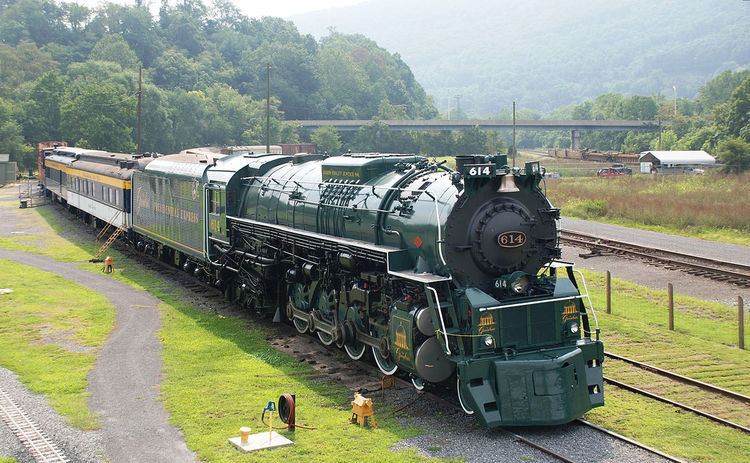Power type Steam Serial number 9306 | Build date June 1948 UIC class 2′D2′ h2 | |
 | ||
Chesapeake & Ohio 614 is a 4-8-4 steam locomotive built by the Lima Locomotive Works in Lima, Ohio, in June 1948 for the Chesapeake and Ohio Railway (C&O) as a member of the J3a class. As one of the last commercially built steam locomotives in the United States, the locomotive was built with the primary purpose of hauling long, heavy, high speed express passenger trains for the Chesapeake & Ohio Railway such as the George Washington and the Fast Flying Virginian. Retired from active service in the late 1950s, the 614 was preserved and placed on display at the B&O Railroad Museum in Baltimore, Maryland. In 1979, the locomotive was restored to operating condition and was used for extensive mainline excursion service from the 1970s until the late 1990s. Today the locomotive is on temporary display at the C&O Railway Heritage Center in Clifton Forge, Virginia awaiting a potential return to steam.
Contents
Background
Most railroads called their 4-8-4s "Northerns," which is short for the railroad first using the 4-8-4 type, Northern Pacific Railroad. The workers of the C&O could not see naming these locomotives "Northerns" as the railroad was based in the southeast. The famous Greenbrier Hotel in White Sulphur Springs, West Virginia, a major resort on the C&O main line, was the inspiration for the name "Greenbrier" applied to these 4-8-4s.
The C&O had a total of 12 4-8-4s, with the first five numbered 600-604 built in 1935, with the designation J-3. In 1942, two more were ordered from Lima numbered 605-606. In 1948, the design changed slightly and the 610-614 were produced, with the J-3-A designation. In 1952, 614 was retired from serrvice and sent to a storage track in a Kentucky roundhouse where she sat for more than two decades. During the time she sat, 614 was renumbered to 611 when there was a power shortage on the B&O as to alleviate any confusion with a leased 4-8-4 that was also numbered 614.
Excursion service
In 1976, 614 was sent to the Baltimore and Ohio Railroad Museum in Baltimore, Maryland and was cosmetically restored.
During 1979, the 614 was sold to Ross E. Rowland Jr. She was restored over the next 18 months with a cost of $1.5 million. During the restoration, 614 was given an auxiliary tender, doubling her water capacity to 50,000 gallons. This allowed the 614 to run for longer times without having to refuel as much. The Chessie Safety Express was 614's first major run, bringing her a bit of spotlight in the process. After the successful system tour, 614 was kept in Hagerstown, Maryland until 1985. American Coal Enterprise was developing a modern steam locomotive to be used as an alternative to rising oil costs by burning coal, known as the ACE 3000 Project. The 614 was modified for better performance under the guidance of David Wardale, and fitted with testing equipment to measure the performance of the engine. For several weeks in January and February 1985, 614 (now 614T, symbolizing it as testing) hauled coal trains between Huntington and Hinton, West Virginia. The 614's fuel consumption costs were actually lower than most diesel locomotives operating at that time. Through out 1996 to 1997, 614 pulled many successful excursions between Hoboken, NJ and Port Jervis, NY
In 1992, Rowland's vision of the 21st Century Limited was taking shape. To give the public an idea of the train, one side of 614 was decorated in a futuristic way with a blue streamlined shrouding and centered headlight. In 1995, 614 was moved to the New Hope and Ivyland Railroad in Pennsylvania for a complete overhaul. It was then used for a series of popular excursions between Hoboken, New Jersey and Port Jervis, New York in conjunction with New Jersey Transit (NJT) between 1996 and 1999.
Current status
614 was required to pull 26 cars at 79 mph on some sections, and maintain speed up several hills. During this time, 614 was equipped with cab signals, 26L brakes, speed control and an MU stand. The 614 was moved to storage on the Reading and Northern Railroad in Port Clinton, Pennsylvania. In 2000. Rowland put 614 up for auction at the NJT maintenance facility, but no buyers were interested. The locomotive is still maintained by Iron Horse Enterprises, the most recent servicing of the locomotive being in 2006.
In 2010, discussions began between Rowland and Jim Justice, owner of the Greenbrier Resort in White Sulfur Springs, West Virginia. The resort owner had been interested in running steam-powered excursion trains from Greenbrier to Washington DC. To be known as the "Greenbrier Express", Justice planned to use steam and diesel power in the project, but would have needed cooperation from CSX Transportation, the Buckingham Branch Railroad and Amtrak. In January 2011, 614 was moved to the Virginia Museum of Transportation for its Thoroughbreds of Steam exhibit. In May 2011, 614 was again moved to the C&O Railway Heritage Center in Clifton Forge, Virginia. From there it went to Clifton Forge, Virginia where it was repainted in preparation for display for the Greenbrier Presidential Express. Unfortunately, the Greenbrier Express project was cancelled in May 2012 due to lack of funding and capacity problems on the CSX portion of the route, where a lack of passing sidings makes it difficult for Eastbound trains to gain headway against the flow of Westbound empty coal trains. The diesels and passenger cars were auctioned off, and 614 continues to sit on display at Clifton Forge. The website for 614 states that once an opportunity to run the engine is finalized, Iron Horse Enterprises will invest the necessary funds to overhaul the locomotive for operation.
